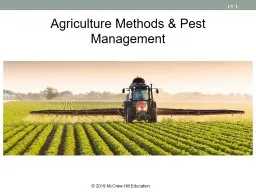/


Agriculture Methods amp Pest Management Energy and Mechanized Agriculture Labor reduction in United States 1913 135 hours of labor required to produce 2500 kg of corn 1980 15 hours of labor required to produce 2500 kg of corn ID: 773132
Download Presentation The PPT/PDF document "Agriculture Methods & Pest Managemen..." is the property of its rightful owner. Permission is granted to download and print the materials on this web site for personal, non-commercial use only, and to display it on your personal computer provided you do not modify the materials and that you retain all copyright notices contained in the materials. By downloading content from our website, you accept the terms of this agreement.
Agriculture Methods & Pest Management
Energy and Mechanized Agriculture Labor reduction in United States: 1913: 135 hours of labor required to produce 2,500 kg of corn. 1980: 15 hours of labor required to produce 2,500 kg of corn. It takes 5 metric tons of fossil fuel to produce 1 metric ton of fertilizer. D eveloped world is dependent on oil to produce energy Energy to m anufacture pesticides and fertilizer and to run machines.
Issues with Single Crop Farming Problems with mechanized monoculture (single crop) agriculture: Large tracts of bare land increases soil erosion. P lanting of genetically identical seeds = loss of genetic diversity. Little genetic differentiation l eads to increased pesticide use. No crop rotation depletes soil nutrients, increasing fertilizer use. Fossil fuel energy use has replaced human muscle power.
14.2 Fertilizer and Agriculture Chemical fertilizers do not replace organic matter, which is important for soil structure. Total dependency on chemical fertilizers reduces the amount of organic matter and can change the physical, chemical, and biological properties of the soil.
14.3 Agricultural Chemical Use P esticide - any chemical used to kill or control populations of unwanted fungi, plants, or animals ( pests ). C ategories of pesticides: Insecticides control insect populations. Fungicides control fungal pests. Herbicides control plant pests.
14.3 Agricultural Chemical Use Herbicides - used to control unwanted plants H eavily used in genetically modified crops. About 60% of pesticides used in U.S. are herbicides. Weeds compete with crops for soil nutrients. Traditional weed control methods are expensive in terms of time and energy.
14.4 Problems with Pesticide Use Characteristics for a perfect pesticide : Inexpensive Only affect target organisms Short half-life Break down into harmless materials Newer pesticides have fewer drawbacks than early pesticides, but still have negative effects.
Bioaccumulation and Biomagnification Bioaccumulation - process of accumulating higher and higher amounts of material within an organism’s body. Many persistent pesticides are fat soluble and build up in fat tissues. Biomagnification - process of acquiring increasing levels of a substance in bodies of higher trophic-level organisms. DDT, mercury, and PCBs are all known to accumulate in ecosystems. DDT was banned in the U.S. in the early 1970s. https://www.youtube.com/watch?v=J9i6a _NRahg
The Biomagnification of DDT
Pesticide Resistance - problem associated with the widespread use of pesticides. Insecticides only kill susceptible individuals. Most surviving individuals have characteristics that allowed them to tolerate the pesticide. Survivors pass on genetic characteristics for tolerance. Subsequent pesticide applications become less effective.
Negative Effects of Pesticides 1. Surviving pests have characteristics that allow for higher tolerance to pesticide Survivors pass on genetic characteristics for tolerance. Subsequent pesticide applications become less effective 2. Most pesticides are not species-specific, - kill beneficial species and pest species. Many kill predator and parasitic insects that normally control pest insects. 3. Health effects to persons applying pesticides – including poisoning with improper use
14.5 Why Are Pesticides So Widely Used? Food Production Worldwide, pests destroy 35% of crops. Economic Concerns Pesticides increase yields and profits. Health Reasons Insecticides curtail many diseases.
14.6 Alternatives to Conventional Agriculture Sustainable agriculture - pr oduce s adequate, safe food supplies in an economically viable manner while protecting or enhancing ecosystem health. Organic agriculture - M ethods that do not involve the use of artificial fertilizers, chemical growth regulators, antibiotics, pesticides, and genetically modified organisms.
14.6 Alternatives to Conventional Agriculture Goals for a sustainable approach to agriculture : Minimize insecticide, herbicide, fungicide, and fertilizer use Conserving soil and water resources. Encouraging biological diversity. Healthy, biologically active soils lead to healthier, more insect- and disease-resistant plants and animals. Natural or supplemented populations of beneficial insects (“good bugs”) will keep pests (“bad bugs”) below economically damaging levels.
Insect Control with Natural Predators Source: Scott Bauer/USDA
Genetically Modified Crops Developing resistant crops Genetic engineering or biotechnology involves inserting specific pieces of DNA into genetic makeup of organisms. Genetically modified organisms can be developed for pest and herbicide resistance . S ome groups are opposed to the use of genetically modified organisms.
Economic and Social Aspectsof Sustainable Agriculture Modifying farming practices Crop rotation prevent s buildup of specific pests that typically occurs when the same crop is raised in a field year after year. Selective use of pesticides Identification of the precise time when pesticide application will have the greatest effect at the lowest possible dose is a useful practice.